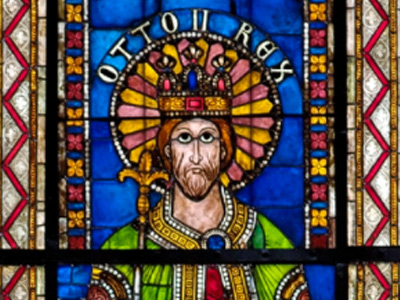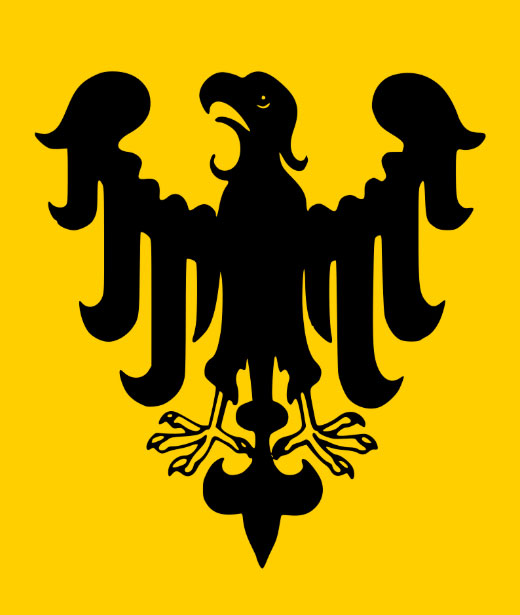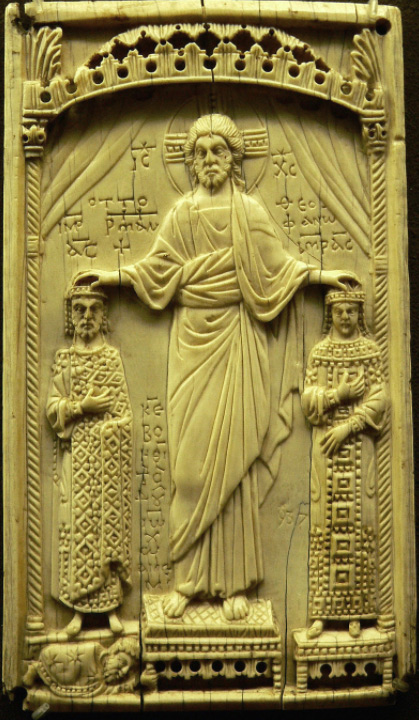Otto II, Holy Roman Emperor (955-983)
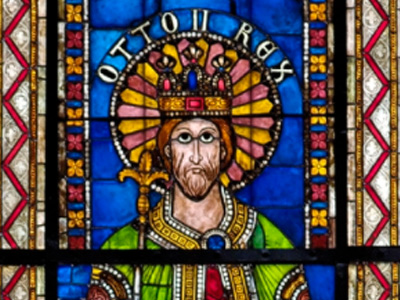
Reign in Italy
Papal Politics
With his rule north of the Alps secured and with the birth of his heir, Otto II shifted his focus to Italy. The situation south of the Alps was chaotic. Pope Benedict VI, who had been appointed by Otto I, had been imprisoned by the Romans in Castel Sant'Angelo. When Otto II sent an imperial representative, Count Sicco, to secure his release, Crescentius I and Cardinal Franco Ferrucci had Benedict VI murdered while still in prison in 974. Cardinal Franco Ferrucci then crowned himself as Benedict VI's successor, becoming Antipope Boniface VII. A popular revolt, however, forced Boniface VII to flee to Constantinople, taking a vast treasure with him. In October 974, under the direction of Count Sicco, the bishop of Sutri was elected Pope as Pope Benedict VII. Boniface VII was then summarily excommunicated for his unsuccessful attempt to take the papacy.
In 979 Benedict VII's position as ruler of Rome was threatened, forcing the Pope to withdraw from and seek the aid of the Emperor. Accepting the Pope's call for aid, Otto II and Theophano, along with their infant son Otto III, prepared for a march south across the Alps. Otto II appointed Willigis, the Archbishop of Mainz, to serve as his regent over Germany.
In October 980 the Imperial court arrived in Chiavenna and received its first Italian delegations. Otto II arrived in Italy at Pavia on December 5, 980. In Pavia, Otto II and his mother, the dowager empress Adelaide of Italy, were reconciled after years of being apart. Before the imperial family celebrated Christmas together in Ravenna, Otto II received the Iron Crown of Lombardy as the King of Italy. Following the New Year, Otto II led his Imperial court to Rome, reaching the city on February 9, 981, where the Emperor restored Pope Benedict VII to his papal throne without difficulty. In Rome, Otto II held a magnificent court ceremony to mark Easter. The imperial family was joined by Otto II's sister Matilda, Abbess of Quedlinburg, King Conrad of Burgundy and his wife Matilda of France, Duke Hugh Capet of France, Duke Otto of Swabia and Bavaria, and other high secular and religious officials from Germany, Italy and France.
Otto II proceeded to hold court in Rome, making the city his Imperial capital, where he received princes and nobles from all parts of western Europe.
Venetian Affairs
The relationship between the Empire and the Republic of Venice was readdressed during Otto II's reign. In 966, The Doge of Venice Peitro IV married a relative of Otto I. The marriage brought the Empire and Venice into close relationship, with Otto I, in 967, granting a series of commercial agreements to Venice in general and to Pietro IV's family in particular. These agreements strengthened Venice's tie to the Western Empire, which greatly angered the Byzantine Emperor John I Tzimisces as Venice controlled all sea trade between Western Europe and the Byzantine Levant in the East.
Otto I's military protection of Pietro IV ensured his hold over power in Venice despite his autocratic tendencies over the republican city. In 973, however, Otto I died. With Otto II busy suppressing revolts in Germany, the Venetians opposed to Pietro IV found their opportunity to depose him. Imprisoning the Doge within his palace, the Venetians nobles set fire to the building. However, the fire soon spread to Saint Mark's Basilica, resulting in the greater part of the city being burnt. The Doge and his son, also named Pietro, were killed in the blaze, but their bodies were later recovered and respectfully buried. Pietro IV's younger son, Vitale Candiano, survived however, and fled to Otto II's court in Saxony with plans to depose the new pro-Byzantine Doge, Pietro I Orseolo.
Pietro I's conciliating policy towards the Empire was ineffective. After having ruled Venice for four years, Pietro I voluntarily abdicated to become a monk, allowing the pro-Ottonian Vitale to return to Venice as Doge in 977, restoring the city's friendly relationship with the Empire. However, Vitale's reign was short (less than two years) and he too voluntarily abdicated to become a monk. With the position vacant, the pro-Byzantine Tribuno Memmo became the new Doge in 979. With the change in leadership, Otto II was reluctant to renew the city's commercial agreements which his father had previously granted to the city. It was only after the intervention of Otto II's mother, the dowager empress Adelaide of Italy, did the Emperor renew the agreements.
Violence erupted in Venice during 980 when tensions between pro-Ottonian Coloprini family and the pro-Byzantine Morosini family. The Coloprini pleaded with the Emperor for support. Seeing an opportunity to fully incorporate Venice into the Empire, Otto II agreed. Upon arriving in Italy in 981, Otto II immediately imposed a trade embargo against the island republic. While the initial embargo showed little effect on Venice, Otto II imposed a second embargo in 983 which dealt considerable damage to the Venetian economy. The effects were disastrous enough to cause the ruling Venetian families to surrender to Otto II, but Otto II's untimely death that year prevented such action.
Religious Policy
Otto II followed the policy of his father in expanding the importance of the Church in his Empire, in particular the importance of monasticism and monasteries. The Church and its organs served as supporting and stabilizing factor in the Empire's structure. To fulfill these tasks, Otto II strengthened the legal integrity and economic independence of the bishops from the secular nobility. The Ottonians had particular religious interest in Memleben as both Otto II's father Otto I and grandfather Henry I had died there. Otto II and his wife Theophanu enhanced the spiritual importance of the city by establishing a Benedictine Imperial abbey there: the Memleben Abbey. Within a short time, the Memleben Abbey had become one of the richest and most influential of the Imperial abbeys. These measures and the unusual size of the abbey perhaps suggest that Memleben may have been intended as an Imperial Mausoleum for the Ottonians.
Following the suppression of Henry II's rebellion, Otto II used the Empire's monasteries as the location for the treason trials. While his father had founded only one monastery (Otto I later replaced the abbey with the Cathedral of Magdeburg) during his 37 years of reign. Otto II, however, established at least four monasteries: Memleben, Tegernsee, Bergen, and Arneburg. Monasticism became a key part of Otto II's Imperial policy, entrusting the Abbots with key political functions.
Otto II employed monks among his top political advisers, including Ekkehard I and Majolus of Cluny. One of the most important such monks was John Philagathus (the future Antipope John XVI). Of Greek descent, John was the personal chaplain of Otto II's wife Theophanu, accompanying her when she traveled from Constantinople to marry Otto II. Otto II appointed him as his Imperial Chancellor from 980 to 982, as well as the Abbot of the Nonantola Abbey. Following Otto II's death in 983, Theophanu, as her son Otto III's regent, would name John as Otto III's tutor. She would later appoint John as the bishop of Piacenza, and would send him to Constantinople to arrange for a marriage between Otto III and a Byzantine princess.
Southern Expansion
In regard to his Italian policy, Otto II went beyond the goals of his father. Not satisfied with the territorial gains made under Otto I, Otto II wanted more. His policy was based not only on securing his power in Rome, or to cooperate with the Papacy, but also to gain absolute dominion over the whole of Italy. Influenced by his wife, who was hostile to the return of the Macedonian Dynasty in the shape of Byzantine Emperor Basil II after the assassination of John I Tzimisces, Otto II was persuaded to annex the Byzantine controlled southern Italy. However, this policy necessarily meant war with not only the Byzantine Empire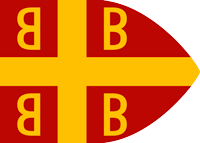 The Byzantine Empire, also referred to as the Eastern Roman Empire or Byzantium, was the continuation of the Roman Empire primarily in its eastern provinces during Late Antiquity and the Middle Ages, when its capital city was Constantinople. It survived the fragmentation and fall of the Western Roman Empire in the 5th century AD and continued to exist for an additional thousand years until the fall of Constantinople to the Ottoman Empire in 1453. but the Muslim Fatimid Caliphate as well, who claimed southern Italy as within their sphere influence.
The Byzantine Empire, also referred to as the Eastern Roman Empire or Byzantium, was the continuation of the Roman Empire primarily in its eastern provinces during Late Antiquity and the Middle Ages, when its capital city was Constantinople. It survived the fragmentation and fall of the Western Roman Empire in the 5th century AD and continued to exist for an additional thousand years until the fall of Constantinople to the Ottoman Empire in 1453. but the Muslim Fatimid Caliphate as well, who claimed southern Italy as within their sphere influence.
The Ottonians' chief lieutenant in central and southern Italy had long been the Lombard leader Pandulf Ironhead. Originally appointed by Otto I as Prince of Benevento and Capua in 961, Pandulf waged war against the Byzantines and expanded Ottonian control to include the Duchy of Spoleto in 967. Under Otto II, Pandulf added the Principality of Salerno in 978 to the Empire. His campaigns under Otto I and Otto II incorporated all three of the southern Lombard principalities - Benevento, Capua, and Salerno - into the Holy Roman Empire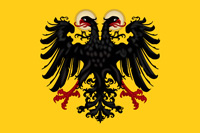 The Holy Roman Empire was a political entity in Western, Central, and Southern Europe that developed during the Early Middle Ages and continued until its dissolution in 1806 during the Napoleonic Wars. From the accession of Otto I in 962 until the twelfth century, the Empire was the most powerful monarchy in Europe. The empire reached the apex of territorial expansion and power in the mid-thirteenth century, but overextending led to partial collapse.. As vassal of Otto II, Pandulf ruled a large bloc of territories that stretched as far north as Tuscany and as far south as the Gulf of Taranto.
The Holy Roman Empire was a political entity in Western, Central, and Southern Europe that developed during the Early Middle Ages and continued until its dissolution in 1806 during the Napoleonic Wars. From the accession of Otto I in 962 until the twelfth century, the Empire was the most powerful monarchy in Europe. The empire reached the apex of territorial expansion and power in the mid-thirteenth century, but overextending led to partial collapse.. As vassal of Otto II, Pandulf ruled a large bloc of territories that stretched as far north as Tuscany and as far south as the Gulf of Taranto.
Pandulf's death in 981 deprived Otto II of one of his primary lieutenants. Pandulf's lands were partitioned among his sons, though further quarrels between the local Lombard princes soon followed. Pandulf's older son Landulf IV received Capua and Benevento while his younger son Pandulf II received Salerno. Upon hearing of Pandulf's death, Otto II, ruling from Rome, traveled south to install Thrasimund IV as Duke of Spoleto. Then, Pandulf's nephew Pandulf II was given Benevento when Otto II partitioned Landulf IV's territory, with Landulf IV keeping Capua. Finally, Duke Manso I of Amalfi deposed Pandulf II of his rule in Salerno in 982.
By 982 the entire area once ruled by Pandulf had collapsed, weakening Otto II's position against the Byzantines. The Byzantines still claimed sovereignty over the Lombard principalities and the lack of singular leader to prevent their advances into Lombard territory allowed the Byzantines to make inroads further north. Otto II attempted on several occasions to reunify the Lombard principalities politically and ecclesiastically into his Empire after Pandulf's death. Though he unsuccessfully besieged Manso I in Salerno, Otto II ultimately obtained the recognition of his authority from all the Lombard principalities.
With his authority reestablished over the Lombard princes, Otto II turned his attention towards the threat from Muslim Sicily. Since 960s the island had been under Muslim rule as the Emirate of Sicily, a state of the Fatimid Caliphate. The ruling Kalbid dynasty had conducted raids against Imperial territories in southern Italy. The death of Pandulf in 981 allowed the Sicilian Emir Abu al-Qasim to increase his raids, hitting targets in Apulia and Calabria. As early as 980 Otto II demanded a fleet from the city of Pisa to help him carry out his war in southern Italy, and in September 981 he marched into southern Italy. Needing allies in his campaign against the Muslims and the Byzantine Empire, Otto II reconciled with Amalfian Duke Manso I, granting Imperial recognition of his rule over Salerno.
Otto II's troops marched on Byzantine-controlled Apulia in January 982 with the purpose of annexing the territory into his Empire. Otto II's march caused the Byzantine Empire to seek an alliance with Muslim Sicily in order to hold onto their southern Italian possessions. The Emperor's army besieged and captured the Byzantine city of Taranto, the administrative center of Apulia, in March 982. After celebrating Easter in Taranto, Otto II moved his army westward, defeating a Muslim army in early July. Emir Abu al-Qasim, who had declared a Holy War (jihad) against the Empire, retreated when he noticed the unexpected strength of Otto II's troops when the Emperor was not far from Rossano Calabro. Informed of the Muslim retreat, Otto II left his wife Theophanu and young son Otto III (along with the Imperial treasury) in the city and marched his army to pursue the Muslim force.
Unable to flee back to his stronghold in Sicily due an Imperial naval blockade, al-Qasim faced the Imperial army in a pitched battle south of Crotone at Cape Colonna on July 14, 982. After a violent clash, a corps of Otto II's heavy cavalry destroyed the Muslim center and pushed towards al-Qasim's guards, with the Emir killed during the charge. Despite the Emir's death, the Muslim troops did not flee the battlefield. The Muslims regrouped and managed to surround the Imperial soldiers, slaughtering many of them and inflicting a severe defeat upon the Emperor. According to the historian Muslim Ibn al-Athir, Imperial casualties numbered around 4,000. The Lombard Princes Landulf IV of Benevento and Pandulf II of Salerno, German Bishop Henry I of Augsburg, German Margrave Gunther of Merseburg, the Abbot of Fulda, and numerous other Imperial officials were among the battle's casualties.
The Imperial defeat shocked the political makeup of Southern Italy. With two Lombard princes dead, the Principalities of Capua and the Benevento passed to younger branches of the Landulfid family. Though the Muslim troops were forced to retreat to Sicily after their victory, the Muslims remained a presence in southern Italy, harassing the Byzantines and Lombards. The Ottonian defeat, the worst in the history of the Empire at the time, greatly weakened Imperial power in southern Italy. The Byzantines joined forces with the Muslims and regained possession of Apulia from Ottonian forces.
HISTORY
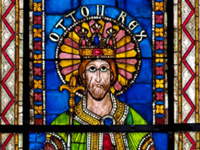
RESOURCES
This article uses material from the Wikipedia article "Otto II, Holy Roman Emperor (955-983)", which is released under the Creative Commons Attribution-Share-Alike License 3.0.
© Stories Preschool. All Rights Reserved.
